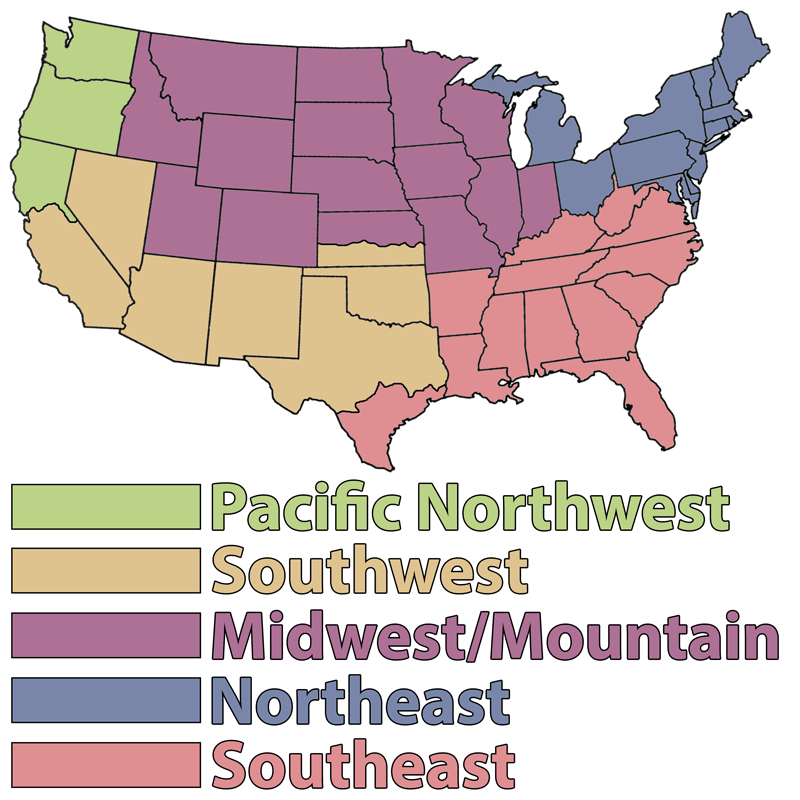Although we think of this as a rainy month, it can fool us. Remember to water your plants more frequently as the weather warms up and the days lengthen.
Gardening "To Do" Tips by Month for Greenville, DE
Apply horticultural oil to trees and shrubs that had insect issues last year. Spray when temperatures are over 40 degrees F.
Plant lilies-of-the-valley, violets, and garden lilies. Divide summer- and fall-blooming perennials, including delphiniums, irises, chrysanthemums, daisies, and phlox.
Check your apple trees. If new shots seem blacked, you may have blight disease. Prune infected areas several inches below the damage. Dip your pruners in a weak bleach solution between pruning cuts to avoid spreading the disease to other trees.
When preparing to transplant seedlings, it is important to harden them off. Water the seedlings less for a week prior to planting. Set the seedlings outside in a wind-protected place when temperatures are above 50 degrees.
Plant cool-season vegetables outside, such as beets, peas, lettuce, collards, turnips, carrots, broccoli (transplants), brussels sprouts, Swiss chard, kale, kohlrabi, onions, parsley, parsnips, radishes, and spinach. See our Best Dates to Plant chart on Almanac.com/Gardening.
Remember to provide adequate soil moisture for your fruit trees during April and May for good fruit size.
Don’t set tomato plants out in the garden too soon. They hate cold soil and cold nights (under 55 degrees F).
Broadcast lime, wood ashes, or a mixture of the two over alkaline-loving perennials such as delphiniums and dianthus. Bring color outdoors to patios, porches, and even the garden with pansy plants, which don’t mind cold nights. To encourage constant flowering, routinely remove spent blossoms and keep them from getting bone-dry.
Once ground thaws, divide any crowded rhubarb stalks. Dig up the whole crown; break off the young side shoots and plant in a full sun location.
Don’t fertilize strawberries in the spring. This is when the leaves are developing, and you’ll get lush growth and meager, soft berries. Wait until blossoms appear and use a light hand.
Plant rosebushes. They often do best if planted before growth starts and buds swell. And if you want to increase their fragrance, surround them with parsley.
Plant bare-root asparagus crowns as soon as the ground thaws. Choose a sunny spot!
Have you considered raised beds? They’re a great way to get your garden started faster in the spring. See Almanac.com for articles on how to build a raised bed.
Rake or remove mulches from all flower beds.
Inspect trees and shrubs for broken limbs and prune damaged branches back to unaffected wood. Cut branches back to a branch or bud that’s facing outward.
Rake your lawn to remove all leaves, dead grass, and small twigs. Sow seed for a new lawn, or fill in bare patches by first covering the area with compost or other organic matter. Roll the lawn if the ground isn’t soggy.
Cover tender plants if late frost is in the forecast.
Begin fertilizing houseplants again.
Feed your trees. As soon as the frost goes out of the ground, give them a well-balanced slow-release fertilizer. Scatter about six good handfuls per each 10x10-foot area. Store leftover fertilizer in a small plastic trash can or a covered plastic container, and label it.
If you have dead spots in the lawn, plan to patch them before the summer heat. Loosen the soil and work in some good-quality compost, sprinkle grass seed, rake lightly, and tamp to assure good seed-to-soil contact. Mulch with a thin layer of straw. Water as needed to keep the soil evenly moist until the grass sprouts.
Avoid planting seedlings until you’ve passed the last frost date for your area. See our Best Dates for Planting Seeds.
If scale or aphids have been a problem on trees and shrubs, spray the branches with dormant oil when temperatures are above 40 degrees.
Have you tested your soil to see if it’s nutrient rich and will allow plants to thrive? Contact your state’s cooperative extension service for free or low-cost soil tests.
Fertilize your trees with a well-balanced, slow-release fertilizer.
If you got your peas in last month, be sure to give them a good fence for support, made of chicken wire, twine, or stubby branches that are at least three feet tall. Otherwise, plant them this month as soon as you can.
For overwintered geraniums, cut back 4 to 6 inches and remove the bottom leaves.
Once the garden soil is workable, give it a good stirring and let it sit for several days. Then top-dress it with compost or well-rotted manure.
Plant perennials and shrubs early in the season to make sure they are established by summer. Divide perennials that are overcrowded.
To determine whether your garden soil is ready for seeds, grab a good handful of it. If you can form it into a ball, the soil is too wet. If it crumbles through your fingers and reminds you of chocolate cake, it’s ready for planting.
Plants started indoors should be hardened off outdoors in cold frames.
Start seeds indoors for heat-loving crops such as eggplant, tomatoes, and squash.
If you left your ornamental grasses intact last fall, you can go ahead and prune them back to a height of about 6 to 12 inches now, higher for larger clumps.
Plant blackberries, raspberries, strawberries, and fruit trees.
Time to fertilize lawns, roses, raspberries, and woody plants.
When danger of frost has passed, uncover strawberry beds and keep them well watered.
Do you have animal pests? Be sure you put the proper fencing in place before you start the garden. See Almanac.com/Gardening for our pest pages.

